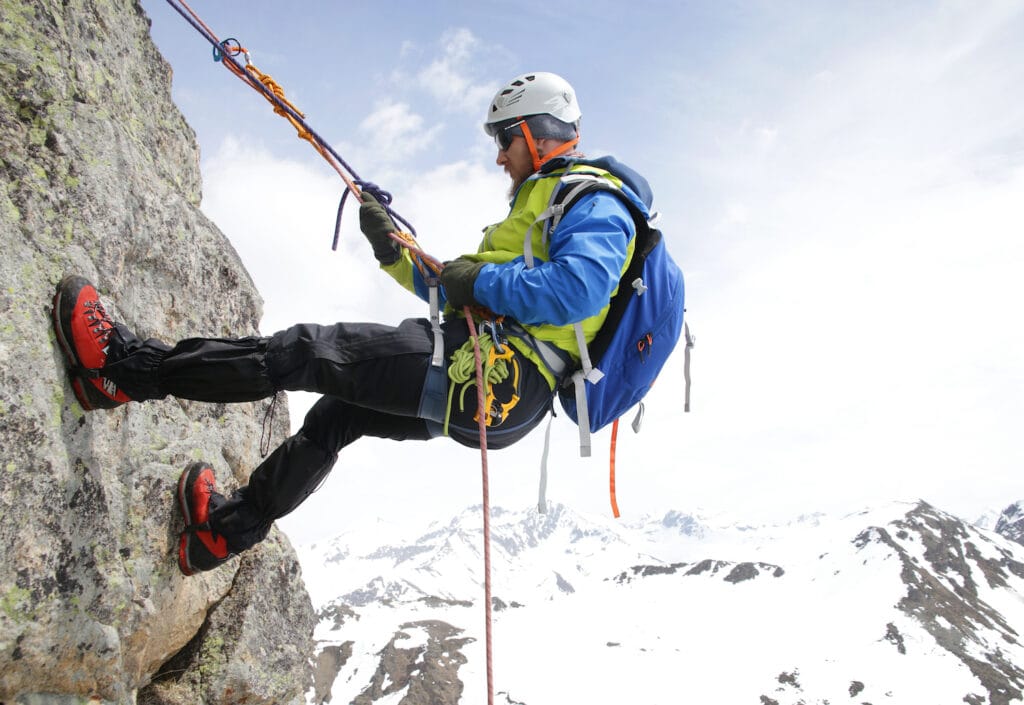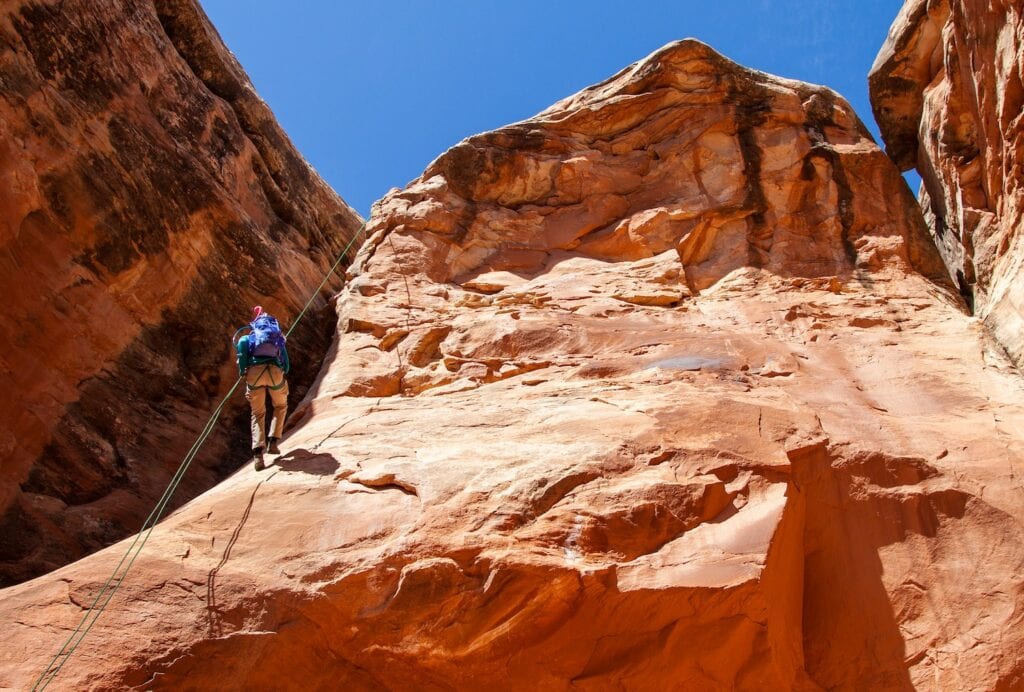Prusik Knot Made Easy: The Ultimate How-To Guide (2024)

Published on: 04/14/2023
As a climbing guide, I frequently get caught up in the hype of new and exciting climbing gear—for example, the debate between a prusik and some other rope-grabbing tool, like a Petzl Tibloc.
Part of that is my wanting to keep my equipment and techniques up to snuff with modern climbing’s best practices. But the other part is my wanting to keep up with the Joneses.
So, because a prusik knot is such a timeless tool, it made sense to do a deep dive and talk about prusik knots and their relationship to a climber’s repertoire of gear and climbing techniques.
What is a Prusik Knot?
A prusik is a knot, also known as a friction hitch, that you attach around a rope in rock climbing, canyoneering, caving, or mountaineering.
The term prusik describes the loop of the cord used to tie the hitch and the hitch itself. In some contexts, prusik is also used as a verb.
The prusik knot is one of the most well-known hitches. Therefore, the term prusik is often used casually to refer to any type of friction hitch.
However, just to make things clear– not all friction hitches are prusiks.

Origin of the Prusik
The prusik knot is named after the Austrian mountaineer Karl Prusik (1). It was first popularized in a 1931 Austrian mountaineering manual for ascending climbing rope.
At the time, it was primarily used to ascend fixed ropes. Nowadays, prusiks are still commonly used to ascend ropes. However, there are other valuable ways to use a prusik hitch that I will describe below.
Advantages of Prusik Hitches
Prusiks are much lighter and cheaper than other tools used to ascend ropes. With practice, you can even rig them with one hand. In addition, the cord or sewn loop is multi-functional and can be used in other contexts.
When properly rigged, prusiks function on single and double ropes. They’ll even work on two ropes with different diameters. In addition, prusiks do not damage the rope’s sheath, unlike mechanical rope-grabbing tools like a jumar.
Prusik hitches can also be used in both directions. They will grab the rope when pulled on the tail, either up or down. You can also slide them along the rope when pushing on the barrel of the hitch.

Disadvantages of Prusik Hitches
Unfortunately, prusiks can be ineffective on wet or frozen ropes. That is because a prusik relies on friction to function correctly. On the other hand, mechanical devices can function on wet, frozen, or dry ropes.
In addition, prusik knots can be difficult to break from the rope after being loaded. This is also true for untying the double fisherman’s knot that most climbers use to create a DIY prusik loop out of an accessory cord.
How a Prusik Knot Works
Prusik knots rely on friction to function correctly. The wraps of the hitch grab the main line and create a slight bend, preventing the prusik knot from sliding. The more wraps you create with the prusik loop, the more friction you make.
Prusik knots may slip if placed under massive loads. However, the typical uses for a prusik, such as ascending a rope or hauling an injured climber, should never place that much force on the hitch.
How to Tie a Prusik Knot
Follow these steps to learn how to tie a prusik knot:
- Place your loop behind the rope.
- Then feed the side with the connecting knot (or sewn junction point) through the other side.
- Now wrap it around the rope loosely, and feed it through again.
- Do this at least three times. However, you may need a fourth wrap, depending on the rope diameter.
- Pull the hitch tight and ensure that the wraps are dressed neatly parallel to one another.
- Ensure that the hitch can grip the rope by pulling on the hitch in one direction.
Making Your Own Prusik with Cord
The most affordable way to incorporate a prusik knot into your climbing equipment is to make your own with an accessory cord.
You can make a prusik loop with a 5 or 6-mm diameter nylon cord. Typically, a length of cord between 120 and 160 centimeters will work. However, you can adjust the length based on your preferences.
You can finish a DIY prusik cord with a double or a triple fisherman’s knot. However, the double fisherman’s knot is the most common.
Pre-Sewn Prusik Loops

If you don’t want to make your own prusik loop, you can purchase pre-sewn prusik loops. A pre-sewn prusik knot is a piece of cord factory-sewn into a loop. The sewn junction point is shrink-wrapped in a plastic sleeve for added durability.
Sterling makes a variety of prusiks and hitch cords. For rock climbing, I recommend either the Sterling 6mm sewn autoblock cord or the 6.8mm Hollowblock.
Three Uses For Prusik Knots
A Prusik knot is a super versatile tool in rock climbing. As a guide, I always carry one on my harness in case I get involved in a rescue scenario. However, more frequently, I use my prusik knot for rappelling.
1. Rappel Back Up
You can rig a friction hitch, such as a prusik knot or autoblock, below your rappel device and attach it to your belay loop with a locking carabiner. In the event you lose control of your rappel strands, the hitch will grip the rope and stop you from rappelling further, so long as your rappel device is extended and the hitch is tied correctly.

2. Ascending a Rope
You can use two prusiks to ascend either a single fixed rope or two strands of rope in a rappelling scenario. You attach the first prusik to your belay loop. Then, attach the second prusik below the first and extend it with a sling to make a foot loop.
3. Assisting or Hauling a Climber
When belaying from above, you can rig a friction hitch onto the climbing rope to quickly assist or pull a climber through a crux section. You can also use friction hitches to haul injured or incapacitated climbers during rescue work.
Different Types of Friction Hitches
The prusik knot is not the only type of friction hitch used in rock climbing. There are two other very common hitches that climbers use all the time–the autoblock (2) and the klemheist.
The Autoblock (aka Machard)
- Start by placing your loop behind the rope so you are left with a large loop on one side and a small loop on the other.
- Wrap the large loop around the rope three times. However, depending on the rope diameter, you may need a fourth wrap.
- Then when you are left with two small loops, clip both loops into a carabiner.
- Pull the hitch tight and ensure that the wraps are dressed neatly parallel to one another.
- Ensure that the hitch can grip the rope by pulling on the hitch in one direction.
For more information, check out our article on the differences between autoblock vs. prusik knots.
The Klemheist
- Start by placing your loop behind the rope so you are left with a loop on one side and a loop on the other.
- Wrap the large loop around the rope three times. However, depending on the rope diameter, you may need a fourth wrap.
- Once you have enough wraps, pass the lower loop through the upper loop and pull it back down.
- Pull the hitch tight and ensure that the wraps are dressed neatly parallel to one another.
- Ensure that the hitch can grip the rope by pulling on the hitch in one direction.
Final Thoughts
Prusik knots and other friction hitches will continue to play an essential role in my recreational climbing and professional guiding work.
They are invaluable tools for backing up rappels, ascending ropes, and hauling climbers.
There may come a day when I use other rope-grabbing tools, but I’ll never get rid of my friction hitch– they are just too dang simple. And if it isn’t broken, why fix it?
Have fun out there! Be safe and check your knots.
Frequently Asked Questions
The tensile strength of a prusik will vary based on the material. For example, a prusik made with a nylon cord can withstand forces between 7 and 10 kilonewtons. On the other hand, the Sterling Hollowblock has a breaking strength of 14 kilonewtons.
A 6 to 7-millimeter diameter nylon cord is best to make prusiks. In most cases, the more significant the difference in diameter between the prusik cord and the main line, the greater the ability for the hitch to grab.
A prusik hitch is used for various applications, such as backing up a rappel, ascending a rope, or hauling.
Typically, a cord length between 120 and 160 centimeters is ideal to tie a prusik.
References
Karl Prusik
Wikipedia (retrieved on 04/14/2023)
https://en.wikipedia.org/wiki/Karl_Prusik
The Machard Knot
SummitPost.org (retrieved on 04/14/2023)
https://www.summitpost.org/the-machard-knot/936995



